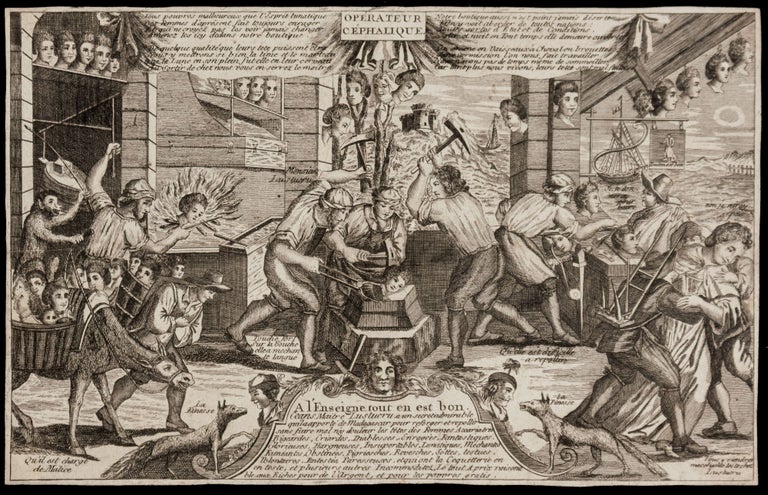
Opérateur Céphalique.
4to etching [31.0 x 19.6 cm], (1) etched sheet, trimmed inside the platemark, verso dusty and with contemporary annotations, excellent. Very rare, separately published 17th-century etching depicting one of the most iconic – and certainly one of the most misogynistic – scenes relating to the querelle des femmes (or “the woman question”) in Early Modern France. This extraordinarily bizarre print depicts the shop of the fictional blacksmith Lustucru, who ran a thriving business 're-forging' the heads of wives unwilling to conform to the behaviors demanded by their husbands. The story and iconography of Lustucru apparently derive from a now-lost almanac published in Paris in 1659, perhaps in response to the opening in that year of Molière’s comedy Les précieuses ridicules, a play which satirized the culture of overly witty women who considered themselves to be more refined than their boorish suitors (see Avalon, p. 98). The image of Lustucru as a “brain surgeon” (opérateur céphalique) hammering a woman’s severed head against his anvil seems to have marked a culmination in the feminist/anti-feminist debate, and it quickly proliferated in popular print, often in the form seen in the present etching. As might have been expected, the rise of Lustucru did not settle the feminist/anti-feminist debate or the querelle des femmes: Rival engravings were soon produced (e.g., under the title Le Massacre de Lustucru par les femmes, in which women attack Lustucru with his own smithy tools, decapitate him, and parade about with his disembodied head on a pike) as were satirical pamphlets (e.g., La requeste des femmes presentée à Vulcan, Prince des forgerons: Contre l’operateur cephalique dit, Lustucru). We have been unable to locate any examples of the present etching in institutional collections. The subject was produced in several distinct but similar versions during the 17th and 18th centuries, but today individual examples of these engravings/etchings are very rare: OCLC locates 4 versions of the design at the Bibliothèque nationale de France (Collection Michel Hennin), 2 in the Wellcome Library, 1 at the Musée Carnavalet, 1 at the Louvre, and 1 at the Biblioteca Nacional de España. * K. Dauge-Roth, “Femmes lunatiques: Women and the Moon in Early Modern France,” Dalhousie French Studies, vol. 71 (2005), pp. 3-29; J. Avalon, “Lustucru, Opérateur Céphalique,” Les Nouvelles de l’Estampe, no. 3 (1968), pp. 98-124; J. Avalon, “Lustucru, Opérateur Céphalique qui polit les têtes des femmes,” Aesculape, vol. 25, no. 4 (1935), pp. 103-6; M. Pitsch, “Un médecin imaginaire au XVIIe siècle: Lustrcru Opérateur Céphalique,” Aesculape, vol. 25, no. 4 (1857), pp. 41-49; J. Wilson, “Lustucru From Severed Heads to Ready-Made Meals,” The Public Domain Review (online source, published 12 June 2019); Joan DeJean, “Violent Women and Violence against Women: Representing the ‘Strong’ Woman in Early Modern France,” Signs, vol. 29, no. 1 (2003), pp. 117-147.
Sold
